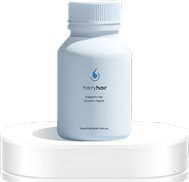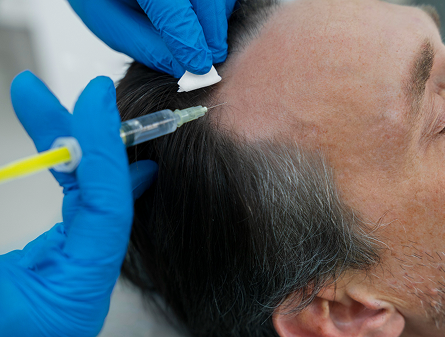Platelet-rich plasma (PRP) treatment involves taking blood from the patient and isolating the PRP to then inject it back into the scalp. Platelets can encourage growth and healing while plasma is the liquid that encompasses the platelets to help them move around the body.
Dutasteride is a treatment for androgenic alopecia that works by lowering the levels of dihydrotestosterone (DHT) in the body. By reducing DHT levels your hair follicles can grow stronger and healthier as the process of miniaturization is prevented.
PRP is a minimally invasive treatment performed in a clinic that can provide short-term results. Dutasteride is a medication that is designed to be used in the long term and can significantly prevent hair loss while promoting healthy regrowth. Check out the comparison table below to see if PRP or dutasteride is right for you.
- PRP uses platelet-rich plasma derived from the patient’s blood to stimulate scalp follicles and promote regrowth.
- Non-surgical and minimally invasive, PRP is best suited for early to moderate hair thinning.
- PRP requires clinic visits and consistent maintenance.
- PRP is favoured by those preferring natural interventions.
- Involves no hormonal manipulation.
- Dutasteride is an oral medication that blocks all three types of 5-alpha-reductase, reducing DHT more effectively than Finasteride.
- Dutasteride is ideal for moderate to advanced male pattern hair loss.
- Taken daily and works systemically.
- Typically prescribed off-label for hair loss.
- Involves hormonal changes and long-term commitment.
- PRP costs are higher per session since it is done in-clinic and in cycles of repeated treatments over some time.
- Compared to Dutasteride, the total cost is likely to be significantly higher, based on the frequency of maintenance.
- Dutasteride is relatively inexpensive, especially in its generic form.
- Compared to PRP, Dutasteride is a cost-effective long-term hair retention solution at minimal initial cost.
- PRP involves monthly sessions over 3 to 6 months, with ongoing treatments needed every 6 to 12 months.
- Compared to Dutasteride’s daily routine, PRP has more structured but less frequent interventions.
- Dutasteride is taken daily and shows results after 3 to 6 months.
- In contrast to PRP’s periodic visits, it is a consistent at-home regimen that requires daily adherence for ongoing success.
- PRP is generally regarded as safe with few side effects, such as transient swelling or pain at the site of injection.
- Unlike Dutasteride, it carries no systemic risk or hormonal interference.
- Dutasteride also carries a higher risk of side effects, including sexual dysfunction or hormonal imbalances in some users.
- Compared to PRP, its internal mechanism introduces more variables and long-term safety concerns.
- PRP is widely considered safe with minimal side effects, including temporary swelling or discomfort at the injection site.
- Unlike Dutasteride, it poses no systemic risk or hormonal interference.
- Dutasteride carries a higher risk of side effects, including sexual dysfunction or hormonal imbalances in some users.
- Compared to PRP, its internal mechanism introduces more variables and long-term safety concerns.
- PRP requires multiple clinic appointments and professional administration.
- While each session is brief, it’s less convenient than Dutasteride’s once-a-day oral routine.
- Dutasteride offers simplicity through a daily pill format that can be easily integrated into daily routines.
- Unlike PRP’s time-intensive appointments, no clinical involvement is required once prescribed.
- PRP is accessible in dermatology and aesthetic clinics across urban centres, but availability may be limited in rural areas.
- Compared to Dutasteride, it is more geographically dependent and cost-restrictive.
- Dutasteride is available via prescription, often off-label for hair loss, and is more widely accessible through GPs or online services.
- Unlike PRP, it doesn’t rely on specialist clinics or equipment.
- PRP offers ongoing improvement with regular sessions, but results may fade if treatments stop.
- Compared to Dutasteride, results are more dependent on continuous professional care.
- Dutasteride maintains results with uninterrupted use, but hair loss often resumes if discontinued.
- Unlike PRP, it relies on constant hormonal suppression rather than stimulation of follicle function.
- PRP integrates well with topical agents and can complement oral therapies like Dutasteride.
- Compared to Dutasteride, it supports external scalp health and may enhance combined therapy outcomes.
- Dutasteride is often used alongside PRP or minoxidil to improve density and retention.
- Unlike PRP alone, its internal action makes it a strong candidate for integrated regrowth protocols.
- PRP attracts users looking for a natural, science-backed treatment with visible but gradual improvement.
- In contrast to Dutasteride, it avoids hormone manipulation and appeals to health-conscious individuals.
- Dutasteride suits individuals who are comfortable with medication and looking for a powerful, low-effort option.
- Compared to PRP, it offers convenience but may raise concerns about side effects or long-term hormonal impact.
- PRP increases circulation, reduces inflammation, and revives tissue in the scalp without altering hormonal systems.
- It is less systemic hormone suppressive than Dutasteride and promotes local healing.
- Dutasteride reduces DHT levels to slow down follicle miniaturisation.
- In contrast to PRP, it does not provide direct nourishment or stimulation of scalp health but acts by avoiding further hormonal damage.
- PRP involves repeated clinic visits and disposable medical equipment, which produces a moderate long-term environmental impact.
- In contrast to Dutasteride, PRP is more resource-demanding.
- Dutasteride has a low environmental footprint due to compact packaging and home use.
- Unlike PRP, it generates minimal waste and avoids transport-related emissions
Shop our hair solutions
We are committed to providing affordable hair regeneration services for people all over Australia. Our formula can help you regain your confidence.
Shop Now

PRP vs Dutasteride Hair Treatment Options Comparison Summary
PRP treatment sessions can be more expensive compared to dutasteride pills. However, you can often enjoy results faster. Dutasteride is meant to be taken in the long run so the regular cost of pills could add up compared to infrequent PRP maintenance sessions. Dutasteride is typically taken as a daily pill so it can easily fit into your routine.
PRP sessions must be performed in a clinic by a medical professional so it can require a time commitment. PRP side effects are more physical including headaches, redness, tenderness, and swelling.
Dutasteride works systemically and the side effects are mostly related to sexual dysfunction including decreased libido, erectile dysfunction and ejaculation issues. PRP treatments may be more accessible than dutasteride.
While PRP treatments need to be performed in a clinic which can require some travel, dutasteride has not been approved for treatment as a hair loss medication in Australia so it can only be prescribed off-label meaning it may be harder to acquire.
User Guidance
If you’re looking for short-term results that can be topped up, PRP treatment may be a good choice for you. Dutasteride is meant to be used as a long-term treatment for hair loss and can be easily incorporated into your daily life.
PRP treatment works well with other hair loss treatments like microneedling in order to improve results along with topical medications like minoxidil. Research is still being conducted into the best combinations for dutasteride but initial results of combining dutasteride, minoxidil, and finasteride are positive.
PRP may be a more suitable treatment if you are in the early stages of hair loss and are looking for a non-pharmaceutical solution to recovering hair growth. Dutasteride is typically suited for people who have tried finasteride and have not seen results as it is a more potent treatment.
Take Our Hair Loss Quiz to See Which Treatment Suits You?
Take A Hair Quiz

Frequently Asked Questions
We have put some commonly asked questions.
Nunc scelerisque tincidunt elit. Vestibulum non mi ipsum. Cras pretium suscipit tellus sit amet aliquet. Vestibulum maximus lacinia massa nontor.
Platelet-rich plasma (PRP) treatment involves drawing blood from the patient, isolating the beneficial nutrients and injecting it into the scalp where hair loss is occurring. This promotes hair growth and has many other applications from encouraging healing to skin rejuvenation.
Platelet-rich plasma (PRP) treatment involves drawing blood from the patient, isolating the beneficial nutrients and injecting it into the scalp where hair loss is occurring. This promotes hair growth and has many other applications from encouraging healing to skin rejuvenation.
Platelet-rich plasma (PRP) treatment involves drawing blood from the patient, isolating the beneficial nutrients and injecting it into the scalp where hair loss is occurring. This promotes hair growth and has many other applications from encouraging healing to skin rejuvenation.







 See All
See All